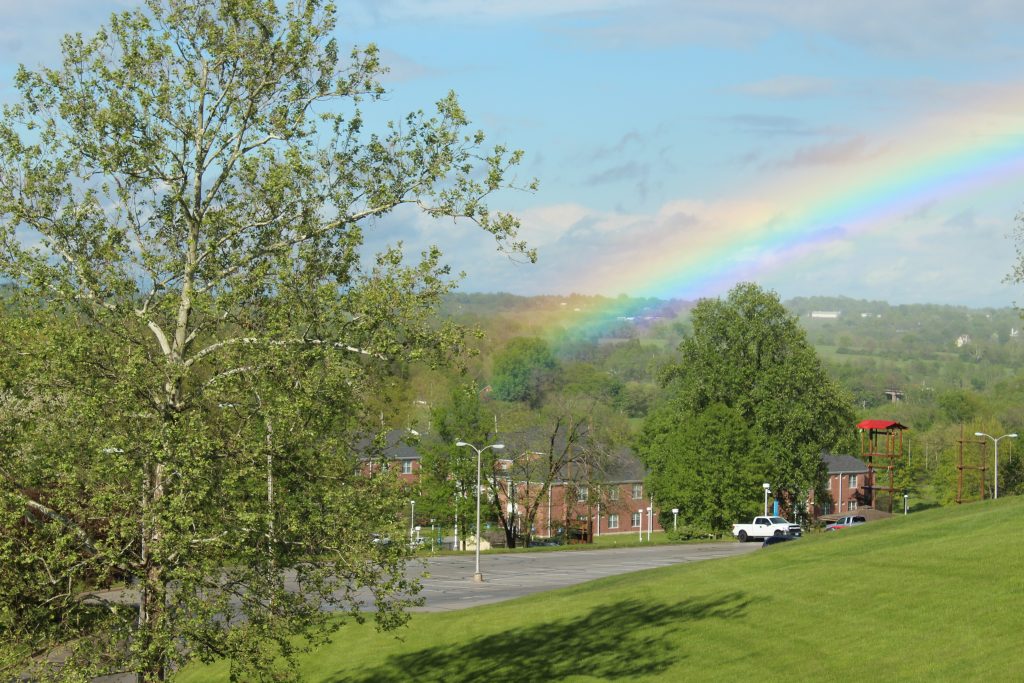
If you’ve been noticing lots of rainbow art on social media – or your neighbors’ porches – it’s not your imagination. In the wake of COVID-19, a movement known as the “rainbow hunt” has taken off.
The movement is simple. Kids and families paint rainbow pictures to hang in the windows, add rainbow sticky notes to their front doors or even decorate the sidewalks with rainbow chalk. Then, families are encouraged to take their kids on “rainbow hunts” while maintaining CDC-recommended social distancing measures to spot out the colorful designs. Facebook groups, such as 518 Rainbow Hunt, are filled with posts of children going on rainbow hunts. Some Facebook groups even include a place for people moved by the artwork to donate to essential workers. However, the main purpose of the rainbow hunt is to provide a fun activity for kids cooped up at home.
“The greater the storm, the brighter the rainbow,” says 518 Rainbow Hunt’s Facebook.
The idea that after the pandemic passes a future as joyful as a rainbow is a very comforting thought, but where did the symbolic meaning of rainbows originate?
The answer is that rainbows have many different meanings for many different groups of people. For Christian communities, the rainbow is a symbol of God’s covenant. According to the book of Genesis in The Bible, God sends a rainbow after a 40-day flood. God says that the rainbow will reappear throughout time as a reminder of God’s protection of the people. This is why many Christians see rainbows as a symbol of hope and safety – two things that we all are in search of during this pandemic.
Another group who the rainbow has great significance to is the LGBTQ+ community. The first rainbow flag was created by Gilbert Baker, a gay rights activist and veteran from Chanute, Kansas. Baker designed the flag in 1978 for a gay pride parade in San Francisco. The original flag included eight colors, each representing something different. Red was for life, orange for healing, green represented nature, purple was for spirit, blue demonstrated peace, yellow was for sun, pink symbolized sex and turquoise stood for magic. Parade-goers were drawn to the brightly colored flag and immediately adopted it as a symbol for LGBTQ+ rights.
After the marriage equality ruling in the U.S. Supreme Court in 2015, the White House was lit up in rainbow colors to celebrate the landmark case. Some conservative Christians claimed that this was the LGBTQ+ community “stealing” the rainbow from the Christian community.
“One day, the rainbow will no longer be misused by sinners to boast in their sin. The rainbow will be reserved for the glory of God alone when Christ returns and makes all things new,” wrote blogger Josh Boice in a seething article.
However, the rainbow does not belong to one specific group of people or have one specific meaning. It is a part of many communities. It is a weather phenomenon that appears above the heads of us all.
In Greek mythology, Iris is the goddess of the rainbow. She is the messenger between the gods and uses rainbows to draw water up from the ocean and back into the clouds. Irish legends associate rainbows with Leperchuans, ornery mythical creatures who leave pots of gold at the end of rainbows. Of course, a rainbow is an optical illusion, which means it has no end – and no gold. At least, that’s what the Leprechauns would like us to believe.
Today, one cultural connotation with rainbows is that of the “rainbow baby.” A rainbow baby is a baby born after a miscarriage, stillborn or loss of a child. The term has gained popularity amongst influencers and parenting bloggers who focus on infertility. It is meant as a term of encouragement and hope and as a way to deal with the complicated emotions that come for parents who have previously lost a child.
For many people, the rainbow has great significance as a sign of good things to come. For others, it may be nothing more than the refraction of light through water droplets in the sky. Either way, in times of struggle, it’s good to keep your eyes open for signs of hope. We can all find our own version of a “rainbow hunt.”
